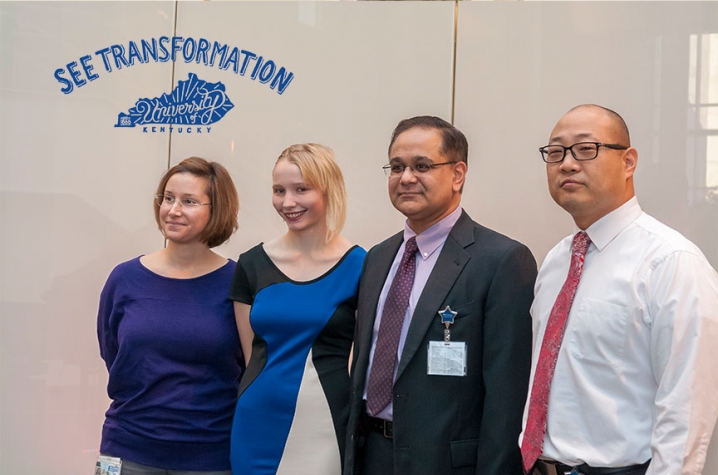Young Epilepsy Patient Overcomes Obstacles to Pursue Dream of Being Performer
[youtube]
LEXINGTON, Ky. (Dec. 8, 2014) — Celeste Shearer beat leukemia at the age of 5 only to develop crippling seizures as a child. By the time she was in high school, the Hart Countian was having three to four seizures a month. Many of them were "clustered," meaning she'd have several over the space of a day or two, with dormant periods in between.
Epilepsy is a common neurological condition where electrical disturbances in the brain can cause seizures. Outward signs of a seizure are extremely varied, but might include twitching, repeated blinking of the eyes or rapid eye movement, garbled speech or other speech difficulties, or a loss of consciousness. Nearly 3 million Americans have epilepsy, and upwards of 30 percent of those people are severely affected.
Epileptics cannot drive for safety reasons, and epilepsy can interfere with schoolwork, extracurricular activities and a social life.
"It's an understatement that I didn't have a normal childhood," Celeste says. "It was difficult to even spend a lot of time at a friend's house or go to a slumber party, because my parents would worry that I might have a seizure."
Celeste tried six different types of medication — both alone and in combinations — to prevent her seizures, without success. The medications also had terrible side effects that left her anxious, angry, depressed, and disinterested in food. At one point she weighed just 80 pounds.
Worst of all, Celeste was an avid performer. The possibility of a seizure was a constant threat for this singer, French horn player, and "Poetry Out Loud" competition finalist.
Her father, Greg Shearer, watched helplessly as Celeste suffered.
"She was so frustrated by her school situation," he said. "She still tried to do marching band and theater, but the seizures would interfere. She had to be carried off the practice field several times."
Then Celeste and her parents met Dr. Sid Kapoor, director of the UK Epilepsy Network. In that first appointment, Kapoor knew immediately that Celeste's epilepsy was refractory, or drug resistant. Celeste's only option was to have surgery to remove the parts of her brain that were causing her seizures.
Usually this surgery involves removing about 4.5 centimeters of tissue from the left side of the brain and 6.5 centimeters from the right.
"It's normal to assume that all patients want the same outcome for their surgery: to preserve the left part of the brain, which controls speech," Kapoor said. "Thankfully, I asked Celeste what was important to her. She made it clear right from the start that her aspirations to become a professional performer meant that she also needed to preserve her ability to sing and perform — which can involve the right side of the brain."
For Celeste, Dr. Kapoor and his team needed to chart new territory: determining how much to take from the right side of the brain without compromising Celeste's ability.
That involved revamping the usual process. The team met to develop a series of complicated tests designed specifically to pinpoint the areas of Celeste's brain that responded to music.
"There were a lot of people involved," Kapoor said. "This went way beyond the usual process for an epilepsy patient."
First, Celeste underwent a functional MRI, during which Kapoor's team played music for her.
Then came highly sophisticated WADA testing. Celeste was kept awake while a catheter was snaked into her skull to deliver a medicine that “disconnects” small parts of the brain for about three minutes.
As the clock ticked, the team asked Celeste to sing. They repeated this process multiple times, using the collected data to map exactly which portions of Celeste's brain to preserve.
"It was an elegant solution to a challenging problem," Kapoor said. "The team worked together so seamlessly, forging new territory, to achieve this goal."
Kapoor and his team ended up taking less tissue from the right side than the usual 6.5 cm. It worked. Within a month, Celeste was seizure free and singing again. In fact, removing the tissue that was short-circuiting her brain and causing the seizures has actually improved her singing ability.
"We asked Celeste to sing for some colleagues, and she chose 'Under the Sea' from 'The Little Mermaid.' Everyone in the room was moved. I don't think there was a dry eye in the house," Dr. Kapoor said.
"The summer after my surgery was the first summer I could be a real teenager," Celeste says. "I could stay up late with friends and not worry about getting overtired, which would bring on a seizure."
Then Northern Kentucky University called offering Celeste a fine arts scholarship. Her dream was back on track.
"We are delighted that Celeste has the opportunity to pursue her dreams of performing on stage," said Greg Shearer. "Even though we have moved to the other side of the state we still go to UK for our major health care needs. I don't think I could trust anyone else."






